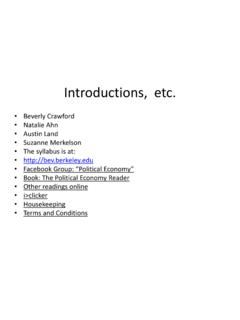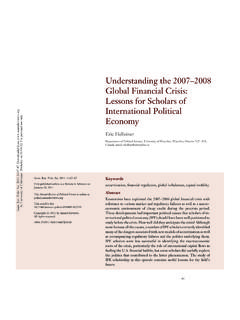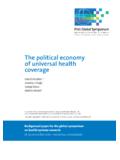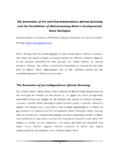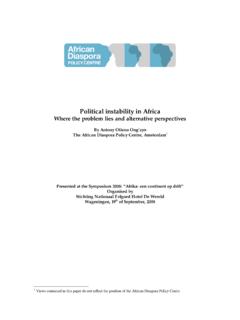Transcription of fragment on machines
1 The fragment on machines Karl Marx from The Grundrisse (pp. 690-712) [690] The labour process. -- Fixed capital. Means of labour. machine . -- Fixed capital. Transposition of powers of labour into powers of capital both in fixed and in circulating capital. -- To what extent fixed capital ( machine ) creates value. -- Lauderdale. machine presupposes a mass of workers. Capital which consumes itself in the production process, or fixed capital, is the means of production in the strict sense. In a broader sense the entire production process and each of its moments, such as circulation -- as regards its material side -- is only a means of production for capital, for which value alone is the end in itself. Regarded as a physical substance, the raw material itself is a means of production for the product etc. But the determination that the use value of fixed capital is that which eats itself up in the production process is identical to the [691] proposition that it is used in this process only as a means, and itself exists merely as an agency for the transformation of the raw material into the product.
2 As such a means of production, its use value can be that it is merely the technological condition for the occurrence of the process (the site where the production process proceeds), as with buildings etc., or that it is a direct condition of the action of the means of production proper, like all mati res instrumentales. Both are in turn only the material presuppositions for the production process generally, or for the employment and maintenance of the means of labour. The latter, however, in the proper sense, serves only within production and for production, and has no other use value. Originally, when we examined the development of value into capital, the labour process was simply included within capital, and, as regards its physical conditions, its material presence, capital appeared as the totality of the conditions of this process, and correspondingly sorted itself out into certain qualitatively different parts, material of labour (this, not raw material, is the correct expression of the concept), means of labour and living labour.
3 On one side, capital was divided into these three elements in accordance with its material composition; on the other, the labour process (or the merging of these elements into each other within the process) was their moving unity, the product their static unity. In this form, the material elements -- material of labour, means of labour and living labour -- appeared merely as the essential moments of the labour process itself, which capital appropriates. But this material side -- or, its character as use value and as real process -- did not at all coincide with its formal side. In the latter, (1) the three elements in which it appears before the exchange with labour capacity, before the real process, appeared merely as quantitatively different portions of itself, as quantities of value of which it, itself, as sum, forms the unity.
4 The physical form, the use value, in which these different portions existed did not in any way alter their formal identity from this side. As far as their formal side was concerned, they appeared only as quantitative subdivisions of capital; (2) within the process itself, as regards the form, the elements of labour and the two others were distinct only in so far as the latter were specified as constant values, and the former as value-positing. But as far as their distinctness as use values, their [692] material side was concerned, this fell entirely outside the capital's specific character as form. Now, however, with the distinction between circulating capital (raw material and product) and fixed capital (means of labour), the distinctness of the elements as use values is posited simultaneously as a distinction within capital as capital, on its formal side.
5 The relation between the factors, which had been merely quantitative, now appears as a qualitative division within capital itself, and as a determinant of its total movement (turnover). Likewise, the material of labour and the product of labour, this neutral precipitate of the labour process, are already, as raw material and product, materially specified no longer as material and product of labour, but rather as the use value of capital itself in different phases. As long as the means of labour remains a means of labour in the proper sense of the term, such as it is directly, historically, adopted by capital and included in its realization process, it undergoes a merely formal modification, by appearing now as a means of labour not only in regard to its material side, but also at the same time as a particular mode of the presence of capital, determined by its total process -- as fixed capital.
6 But, once adopted into the production process of capital, the means of labour passes through different metamorphoses, whose culmination is the machine , or rather, an automatic system of machinery (system of machinery: the automatic one is merely its most complete, most adequate form, and alone transforms machinery into a system), set in motion by an automaton, a moving power that moves itself; this automaton consisting of numerous mechanical and intellectual organs, so that the workers themselves are cast merely as its conscious linkages. In the machine , and even more in machinery as an automatic system, the use value, the material quality of the means of labour, is transformed into an existence adequate to fixed capital and to capital as such; and the form in which it was adopted into the production process of capital, the direct means of labour, is superseded by a form posited by capital itself and corresponding to it.
7 In no way does the machine appear as the individual worker's means of labour. Its distinguishing characteristic is not in the least, as with the means of labour, to transmit the worker's activity to the object; this activity, rather, is posited in such a way that it merely transmits the machine 's work, the machine 's action, on to the raw material -- supervises it and guards against interruptions. Not as with the [693] instrument, which the worker animates and makes into his organ with his skill and strength, and whose handling therefore depends on his virtuosity. Rather, it is the machine which possesses skill and strength in place of the worker, is itself the virtuoso, with a soul of its own in the mechanical laws acting through it; and it consumes coal, oil etc. (mati res instrumentales), just as the worker consumes food, to keep up its perpetual motion.
8 The worker's activity, reduced to a mere abstraction of activity, is determined and regulated on all sides by the movement of the machinery, and not the opposite. The science which compels the inanimate limbs of the machinery, by their construction, to act purposefully, as an automaton, does not exist in the worker's consciousness, but rather acts upon him through the machine as an alien power, as the power of the machine itself. The appropriation of living labour by objectified labour -- of the power or activity which creates value by value existing for-itself -- which lies in the concept of capital, is posited, in production resting on machinery, as the character of the production process itself, including its material elements and its material motion. The production process has ceased to be a labour process in the sense of a process dominated by labour as its governing unity.
9 Labour appears, rather, merely as a conscious organ, scattered among the individual living workers at numerous points of the mechanical system; subsumed under the total process of the machinery itself, as itself only a link of the system, whose unity exists not in the living workers, but rather in the living (active) machinery, which confronts his individual, insignificant doings as a mighty organism. In machinery, objectified labour confronts living labour within the labour process itself as the power which rules it; a power which, as the appropriation of living labour, is the form of capital. The transformation of the means of labour into machinery, and of living labour into a mere living accessory of this machinery, as the means of its action, also posits the absorption of the labour process in its material character as a mere moment of the realization process of capital.
10 The increase of the productive force of labour and the greatest possible negation of necessary labour is the necessary tendency of capital, as we have seen. The transformation of the means of labour into machinery is the realization of this tendency. In machinery, objectified labour materially confronts living labour as a ruling power and as an active subsumption of the latter under itself, not only by appropriating it, [694] but in the real production process itself; the relation of capital as value which appropriates value-creating activity is, in fixed capital existing as machinery, posited at the same time as the relation of the use value of capital to the use value of labour capacity; further, the value objectified in machinery appears as a presupposition against which the value-creating power of the individual labour capacity is an infinitesimal, vanishing magnitude.
